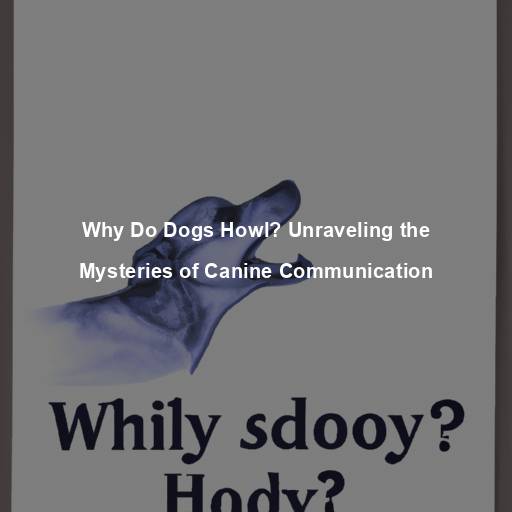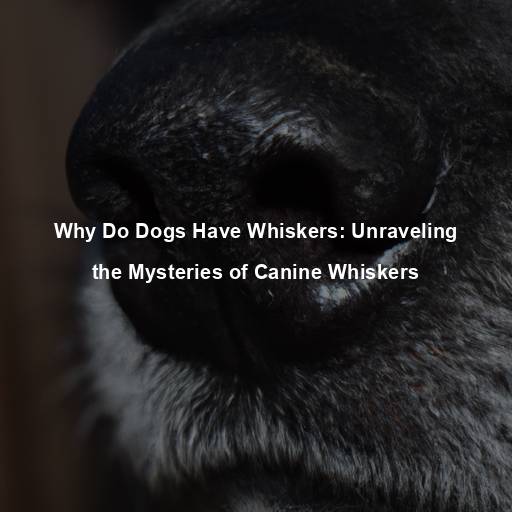Why Do Dogs Howl? Unraveling the Mysteries of Canine Communication
Last Updated on August 3, 2023 by Evan
Contents
- 1 The Enigmatic Howl: A Window into Canine Communication
- 1.1 The Origins of Howling: A Primitive Call
- 1.2 Expressing Emotion: Howling as an Emotional Outlet
- 1.3 Howling for Attention: Seeking Connection
- 1.4 Joining the Chorus: Howling as a Group Activity
- 1.5 The Call of the Wild: Howling and Ancestral Instincts
- 1.6 Communication Beyond Words: Howling for Survival
- 1.7 Health Concerns: When Howling Signals Discomfort
- 1.8 The Melody of Canine Expression: Celebrating the Howl
- 1.9 Longing for Companionship: Separation Anxiety and Howling
- 1.10 Singing to the Moon: Howling and the Nighttime Ritual
- 1.11 The Language of Scent: Howling and Marking Territory
- 1.12 In Sync: Howling and Synchronizing with Other Dogs
- 1.13 Singing the Blues: Howling and Emotional Distress
- 1.14 The Power of Consolation: Dogs Howling in Response to Sirens
- 1.15 Breed-Specific Vocalizations: Howling in Certain Dog Breeds
- 1.16 Training and Modifying Howling Behavior
- 2 FAQs for How Dogs Howl
The Enigmatic Howl: A Window into Canine Communication
Dogs, those enigmatic and captivating creatures that have stood by our side for centuries, never cease to bewilder us. Through their array of sounds, they communicate in ways that both intrigue and baffle us. One of these peculiar vocalizations is the haunting howl, an iconic and mysterious sound that can evoke an array of emotions within us. Whether it’s under the moonlit sky or during moments of intense feeling, the question remains: why do dogs howl?
The Origins of Howling: A Primitive Call
To understand why dogs howl, we must first explore their ancestry. Dogs are descended from wolves, and it is believed that howling is a behavior inherited from their wild ancestors. Wolves howl to communicate with their pack members over long distances, conveying messages about territory, location, and social bonding. Similarly, domesticated dogs still retain this instinctual behavior, albeit with some variations.
Expressing Emotion: Howling as an Emotional Outlet
Dogs, intricate emotional creatures, possess a kaleidoscope of sentiments that dot the vast landscape of their souls. In their captivating repertoire of emotional expressions, the ethereal symphony of howling emerges as a mesmerizing outlet, allowing them to release an array of feelings: be it sheer elation, profound solitude, gripping trepidation, or even harrowing pain. This hauntingly beautiful ritual of their vocalization holds a transcendental purpose—a heartfelt means of communication to fellow canines and the very humans who share their lives—a poignant message whispered through the melodious winds, imploring, “Behold, I am here” or “Please, attend to my being”.
Howling for Attention: Seeking Connection
If you’ve ever observed your furry companion unleashing a haunting howl upon your departure or during moments of separation, you might find yourself wondering why such an enigmatic conduct occurs. Well, dear reader, delve into the fascinating world of canine psychology, and you’ll discover that this peculiar behavior stems from an innate desire for attention and connection. It is an irrefutable fact that dogs are inherently social creatures, finding solace and fulfillment within their pack-like dynamics. In times of isolation or unease, these sentient beings may resort to unleashing their emotive howls as a heartfelt plea for the return of their cherished pack members or their beloved humans.
Joining the Chorus: Howling as a Group Activity
Howling is not always an individual endeavor. Dogs are known to engage in communal howling, especially when they hear other dogs or even certain sounds that trigger their instinctual response. This behavior is most commonly observed in wild wolf packs, where howling serves as a unifying force, reinforcing social bonds and coordinating group activities. In a domestic setting, dogs might howl together in response to sirens, musical instruments, or even certain high-pitched sounds.
The Call of the Wild: Howling and Ancestral Instincts
There’s a certain mystique surrounding our beloved canine companions, a hidden connection to their untamed predecessors that lingers beneath their domesticated exterior. You see, in the depths of their being, dogs still carry the echoes of their wild heritage, a spark of ancestral energy that can be ignited by peculiar triggers. It’s as if a primitive switch is flipped when the moon shines its brightest or the distant chorus of fellow howlers reaches their velvet ears. In these fleeting moments, these four-legged creatures are transported back to a time long before domestication, a time when their roots ran wild and free, paying tribute to their ancient lineage in a chorus of soul-stirring howls.
Communication Beyond Words: Howling for Survival
In some cases, howling serves a practical purpose for dogs. When lost or injured, a dog may resort to howling as a means of attracting attention and help. By emitting a distinctive sound that carries over long distances, they increase their chances of being heard by potential rescuers or their pack members. Howling becomes a beacon of hope, a desperate plea for assistance in times of distress.
Health Concerns: When Howling Signals Discomfort
While howling is generally a natural and normal behavior for dogs, excessive or sudden changes in howling patterns can sometimes indicate underlying health issues. If your dog starts howling more frequently or in a different manner than usual, it’s essential to pay attention and consult a veterinarian. Howling can be a symptom of pain, anxiety, cognitive decline, or even certain medical conditions. Understanding the context and accompanying behaviors can provide valuable insights into your dog’s well-being.
The Melody of Canine Expression: Celebrating the Howl
In conclusion, the howl of a dog is a multifaceted expression that encompasses their ancestral instincts, emotional needs, and desire for connection. It serves as a powerful form of communication, allowing dogs to convey their emotions, seek attention, and establish social bonds. While its origins lie in the wild, the howl has found a place in our hearts and has become an integral part of the human-canine relationship.
As individuals tasked with the noble duty of being responsible pet owners, we are faced with the perplexing task of comprehending and valuing this extraordinary method of communication. By attuning our senses to the melodious howls of our beloved furry companions, we have the opportunity to forge a connection that transcends the ordinary. In doing so, we can nourish their souls with the affection, tenderness, and devotion they yearn for. So, when you next encounter the harmonious decree of your four-legged confidant, halt momentarily, absorb the enigmatic symphony, and rejoice in the majesty of the canine lyrical expression.
Note: Dogs communicate in various ways, and howling is just one aspect of their rich repertoire. Understanding their body language, vocalizations, and behaviors as a whole will enable us to truly connect with our four-legged companions and foster a harmonious relationship based on trust and understanding.## The Howling Symphony: Variations and Meanings
Longing for Companionship: Separation Anxiety and Howling
Dogs possess a remarkably profound capacity for social connection, making them creatures of great emotional depth. It is in these depths that their howling reveals a perplexing symphony of separation anxiety. When our loyal canine companions are left unaccompanied for extended periods, a storm of distress and despair cascades within their beings, provoking them to unleash their haunting howls in a desperate quest for solace and connection. This phenomenon is especially prevalent among those dogs whose hearts beat in sync with their devoted human counterparts.
Singing to the Moon: Howling and the Nighttime Ritual
We all know that our furry friends can be quite the party animals when the sun goes down. It’s like they channel their inner ancestors and become one with the moonlit sky. Their inherent instincts take center stage as they howl into the night, a symphony of communication and celebration. Whether they’re connecting with their canine compadres, expressing pure bliss, or just basking in the enchanting atmosphere, their nocturnal performances will always leave us in awe.
The Language of Scent: Howling and Marking Territory
Dogs have a remarkable sense of smell, and they use scent marking as a means of communication. Howling can be closely linked to this territorial behavior. By emitting their distinctive howl, dogs may be signaling to other animals that they are claiming a particular area as their own. It’s a way of saying, “This is my territory, and I’m here to protect it”.
In Sync: Howling and Synchronizing with Other Dogs
Have you ever noticed how dogs in the same neighborhood seem to start howling one after another, creating a harmonious symphony of sound? This phenomenon can be attributed to dogs’ innate ability to synchronize their behaviors. When one dog starts howling, others in the vicinity may join in, creating a chorus of voices. This synchronicity is rooted in their pack mentality and serves as a way of reinforcing social bonds and displaying unity among the canine community.
Singing the Blues: Howling and Emotional Distress
Just like humans, dogs can experience moments of emotional distress or discomfort. When they are in pain, feeling anxious, or even grieving the loss of a companion, dogs may express their emotions through howling. This mournful sound can be a cathartic release, allowing them to externalize their feelings and seek solace. As pet owners, it’s important to be attuned to our dogs’ emotional well-being and provide them with the support and care they need during challenging times.
The Power of Consolation: Dogs Howling in Response to Sirens
It’s no secret that dogs have an uncanny ability to tune in to the world around them, often picking up on things we humans don’t even notice. And when it comes to those shrill sirens that pierce through the air, our furry friends can’t help but be captivated. With their acute hearing and innate instincts, they’re like antennae, receiving the transmission of the unfamiliar sound. It’s almost as if they’re trying to decipher its meaning, searching for a way to connect with the source of the noise.
Breed-Specific Vocalizations: Howling in Certain Dog Breeds
While dogs of all breeds can howl, some breeds are more inclined to vocalize in this manner. For example, Siberian Huskies, Alaskan Malamutes, and other Nordic breeds are known for their impressive howling abilities. These breeds have a strong genetic predisposition for vocalization, and their howls can be particularly melodic and resonant. Understanding breed-specific tendencies can help us appreciate and embrace the unique characteristics of different dog breeds.
Training and Modifying Howling Behavior
Dealing with a dog’s excessive or disruptive howling can be quite the puzzle. When the howling becomes a real headache for you or your neighbors, it’s time to roll up your sleeves and seek expert advice to decode the situation. By employing positive reinforcement techniques, you can unravel the mystery behind your dog’s howling and guide them towards more constructive means of expression. Through training and behavior modification, you can help your furry friend find healthier ways to communicate and manage their emotions.
FAQs for How Dogs Howl
What is howling in dogs?
Howling is a vocal behavior exhibited by dogs that involves a long, sustained, and often mournful sound. It is a natural form of canine communication and can be used for various reasons such as expressing emotions, alerting others of danger, seeking attention, or simply following their instinctual behavior.
Why do dogs howl?
Dogs howl for several reasons. One common reason is to communicate with other dogs, especially when they are separated over a long distance. Howling allows them to establish their location and maintain contact with their pack. Dogs may also howl in response to certain sounds, such as sirens or musical instruments, as these noises can trigger their innate instinct to join in vocalizations. Additionally, dogs may howl when they experience anxiety, loneliness, or if they are seeking attention from their owners.
Do all dogs howl?
It’s quite captivating to ponder the enigmatic world of canine vocalizations. It seems that howling, a ubiquitous behavior linked to our furry friends, possesses a mesmerizingly unpredictable nature. While we may assume that all dogs partake in this melodic symphony, the truth eludes us, showcasing the bewildering diversity of our four-legged companions. It appears that there exists a captivating array of individual predispositions, with certain breeds, like the illustrious Huskies and Beagles, particularly inclined to unleash their vocal prowess upon the world. Paradoxically, those adorned with flatter faces, the brachycephalic breeds, may deem howling as an unfamiliar language, preferring to communicate their desires through other mysterious means.
Can you train a dog to howl?
Yes, it is possible to train a dog to howl on command, but it requires patience and consistency. The first step is to identify situations or triggers that naturally prompt your dog to howl, such as hearing another dog howling or a specific sound. Once you have identified these triggers, you can use positive reinforcement techniques to associate a verbal or visual cue with the desired behavior. By rewarding your dog with treats or praise each time they successfully howl on command, you can gradually shape their behavior to respond to the cue.
Are there medical conditions that cause excessive howling in dogs?
Dogs and their peculiar ways never cease to leave us scratching our heads in puzzlement. Take excessive howling, for instance. Before you throw your hands up in despair and blame it on that strange neighbor next door, consider that there might be more to it. In some cases, this vocal outburst could be your furry friend’s way of expressing an underlying medical condition. So, if you find yourself caught in a whirlwind of canine howls that seem to defy reason, it might be wise to seek guidance from a discerning veterinarian. Through a thorough examination, they can unravel the mystery and help your four-legged companion howl with joy once more.
How should I react when my dog howls?
The perplexing phenomenon of a dog’s howling elicits a burst of questions that demand answers. Understanding the underlying reason behind this canine cacophony is key in responding appropriately. If your four-legged companion emits mournful howls due to fear or distress, offering solace and comfort can work wonders. Yet, if this howling extravaganza becomes an unruly disruption, it becomes crucial to uncover the cause and take swift action. By identifying and eliminating triggers, creating a serene atmosphere, and engaging your furry friend in enriching activities, you can help curb the excess howling. Remember, scolding or punishing your dog may only amplify their perplexity and distress. Instead, opt for positive reinforcement techniques and don’t hesitate to consult a professional if needed.
Can neutering or spaying affect a dog’s howling behavior?
When it comes to a dog’s penchant for howling, the effects of neutering or spaying can be quite enigmatic. While these procedures have been known to influence certain behavioral patterns like tempering aggression or diminishing marking habits, their impact on vocalization inclinations, such as howling, remains somewhat of a puzzle. Nevertheless, it’s vital to remember that each dog is a unique entity, and variations in howling behavior post-neutering or spaying may indeed arise. If you witness any perplexing alterations in your furry friend’s howling tendencies after these procedures, seeking guidance from your trusted veterinarian would be the wisest course of action.






